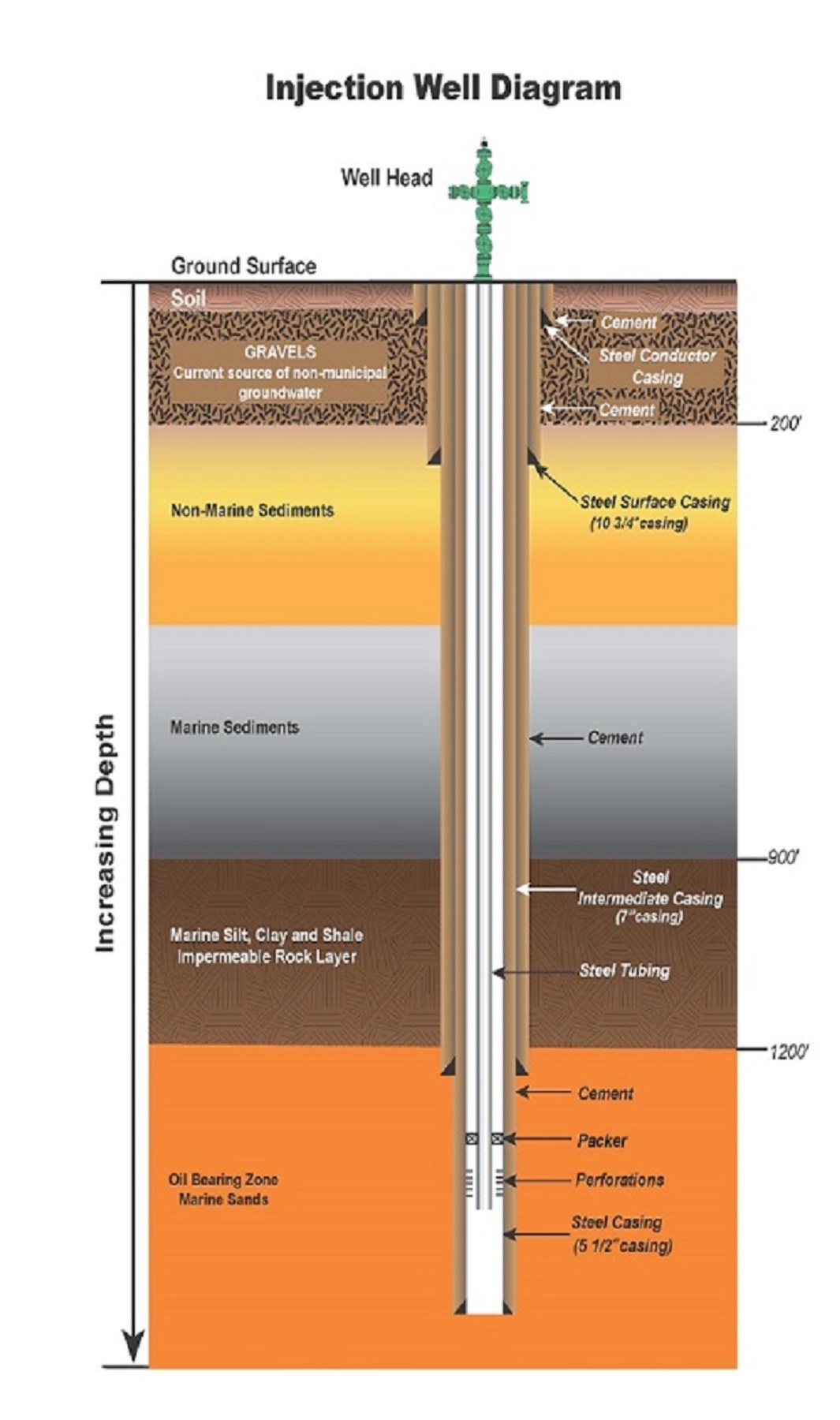
How many injection wells are used in oil and gas operations In California?
About 55,000 injection wells are used for waterflood, steamflood, cyclic steam, and water disposal. These wells are referred to as Class II injection wells in the Underground Injection Control (UIC) Program.
Where are they?
Injection wells are found in many oil and gas fields located in the counties where oil and gas are produced.
What are they for?
Class II injection wells are used to safely dispose of the salt and fresh water produced with oil and gas. Injection is often accomplished in a manner that will increase oil and gas production. About 15 times more water than oil is produced from California's oil and gas fields.
Does injected water have a useful purpose?
Yes. In more than 95 percent of the Class II injection wells, water is injected into petroleum reservoirs to increase oil production. About 60 percent of California's oil production is a result of Class II injection wells.
Is anything besides water injected?
Current state and federal regulations allow nonhazardous fluids produced from oil or gas wells and several other nonhazardous fluids associated with the production process to be injected into a Class II well. These other fluids include diatomaceous earth-filter backwash, thermally enhanced oil recovery cogeneration plant fluid, water-softener regeneration brine, air scrubber waste, drilling mud filtrate, naturally occurring radioactive materials (NORM), slurrified crude-oil, saturated soils, and tank bottoms.
Describe an injection well.
After a well is drilled, sometimes to depths over 5,000 feet, steel pipe called casing is cemented in the hole. The casing and cement prevent fluids in different zones from mixing with each other or with injected fluids. The casing and cement are perforated opposite the injection zone. To provide an extra layer of protection, tubing is placed in the well to a point just above the perforations and a packer is used near the bottom of the tubing to seal it against the casing. The packer prevents water from entering the space between the tubing and casing when water is injected down the tubing. Several tests are run to make sure the well is operating properly and the injected fluids are confined to the intended injection zone, and repeated on a periodic schedule.
Describe an injection zone.
An injection zone is usually sandstone, a rock porous and permeable enough to accept injected fluids. Rock beds chosen for injection zones are covered by impermeable beds, like shale, that act as cap rocks, confining injected liquids in the porous beds.
How is produced water handled?
After oil and gas are separated from the produced water at the producing well, the water is piped or trucked to the injection site. There, the water is transferred to holding tanks and filtered and pumped down a Class II injection well.
How often are injection wells checked?
Geologic Energy Management Division (CalGEM, formerly DOGGR) engineers monitor all injection wells to ensure they are operated properly and have mechanical integrity. Monitoring includes reviewing operational data and running tests such as Mechanical Integrity Tests (i.e., spinner, temperature, and pressure tests and tracer surveys). In addition, most well sites are inspected annually by CalGEM engineers. Samples of the injected fluids may be taken at any time to confirm compliance.
How are injection wells permitted?
Operators of Class II injection wells must file for a permit with CalGEM. Before a permit is issued, the proposed injection project is studied by CalGEM engineers and reviewed by the appropriate regional water quality control board. CalGEM engineers evaluate the geologic and engineering information, solicit public comments, and may hold a public hearing, if necessary. Injection project permits include many conditions, such as approved injection zones, allowable injection pressures, and testing requirements.
Are injection wells safe?
Yes. Class II injection wells provide a viable and safe method to enhance oil and gas production and dispose of produced fluids and other fluids associated with oil- and gas-production operations. In California, Class II injection wells have an outstanding record for environmental protection. A peer review conducted by a national organization, the Ground Water Protection Council, found CalGEM has an excellent program that effectively protects underground sources of drinking water.
Related Information:
